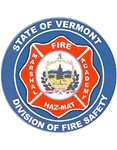Solar Array Installation Memorandum
To: Division of Fire Safety Staff; Electricians Licensing Board
From: Bob Patterson, Deputy Director
Date: October 30, 2012
The Division of Fire Safety has been asked to comment on jurisdiction of solar array installations when not located on a public building or located at an owner occupied single family residence. This memorandum pertains to privately owned solar array installations installed in an open field on a contiguous property with a public building and connected to the public building. Privately owned solar arrays are considered under the jurisdiction of the Division and require electrical permits when the installation is connected to a public building on the premise. Such buildings will also require a construction permit.
The 2011 Vermont Electrical Rules adopt the 2011 National Electric Code (NFPA 70) which specifies in Article 690.31(A) that:
Where photovoltaic source and output circuits operating at maximum system voltages greater than 30 volts are installed in readily accessible locations, circuit conductors shall be installed in a raceway.
The NEC Handbook makes the following comment at this code opening:
“Most PV modules do not have provisions for attaching raceways. These circuits may have to be made “not readily accessible” by use of physical barriers such as wire screening”
While this may suggest a solution, it is not always practical to install physical barriers on each individual module because of the number of modules involved.
In these circumstances we essentially have a privately owned electric supply station which our statutes and rules did not specifically contemplate when crafted. However, the Vermont Electrical Safety Rules also adopt the ANSI C2, National Electric Safety Code (2007 edition) which is better suited to these installations in some instances.
Alternatively, in lieu of protecting each individual module, the Division will also accept protective arrangements complying with the National Electric Safety Code Section 11, 110 (a) which provides that electric supply stations may be guarded by a grounded metal fence with a height that satisfies any one of the following:
a. Fence fabric, 2.13 m (7ft) or more in height.
b. A combination of 1.8 m (6’) or more of fence fabric and an extension utilizing three (3) or more strands of barbed wire to achieve overall height of the fence not less than 7’.
c. Other types of construction, such as nonmetallic material that present equivalent barriers to climbing or other unauthorized entry.
In addition, A safety sign shall be displayed at each entrance and on each side of the enclosure indicating “authorized personnel only”. Entrances shall be kept locked when unattended.
Public utility installations are exempt under 26 V.S.A. § 882. A solar project which is connected directly to utility poles with no building present is exempt based on a “complex structure” having the same meaning as a “public building” defined in 20 V.S.A. §2900(8). This determination is based on a ruling from the Office of the Attorney General dated May 17, 2001 entitled Electrical Jurisdiction.
Sprinklers and Shunt Trip Circuit Breakers
From: Elevator Safety Review Board
Robert A. Patterson, Deputy Director, Board Chair
Date: October 24, 2011
At the October 10, 2011 Board meeting, the topic of shunt trip breakers was discussed relative to elevator operation and safety. The board found no convincing evidence that shunt trip provides improved public safety, but did receive significant testimony to the contrary:
In some situations occupants can be trapped inside the elevator car, should the shunt trip breaker activate when the elevator car is between floors. When the shunt trip is activated fire departments are no longer able to utilize the elevator for rescue or fire operations. Elimination of shunt trip breakers will provide financial benefit to building owners by eliminating the continuing costs of maintaining/repairing the shunt trip feature in an operational state.
The Board determined to eliminate shunt trip circuit breakers subject to the following provisions:
When the elevator machine room is not constructed of non-combustible or limited combustible materials, (steel studs/joist and gypsum) it will be acceptable to provide an additional layer of 5/8” gypsum within the machine room in lieu of a non-combustible enclosure.
Where elevator shaft and machine room is constructed of non-combustible or limited combustible materials, the sprinkler head at the top of shaft must be removed and plugged, the heat detector disconnected from shunt trip breaker, and smoke detector removed. Where buildings have sprinkler protection, a sprinkler head shall be located no more than 24” above the pit floor.
Elevators having shunt trip in place shall have breakers removed or disconnected prior to January 1, 2015. This will allow both fire alarm and sprinkler vendors to complete work during annual inspection.
This action is similar to the State of Massachusetts elevator requirements approved in 2003.

